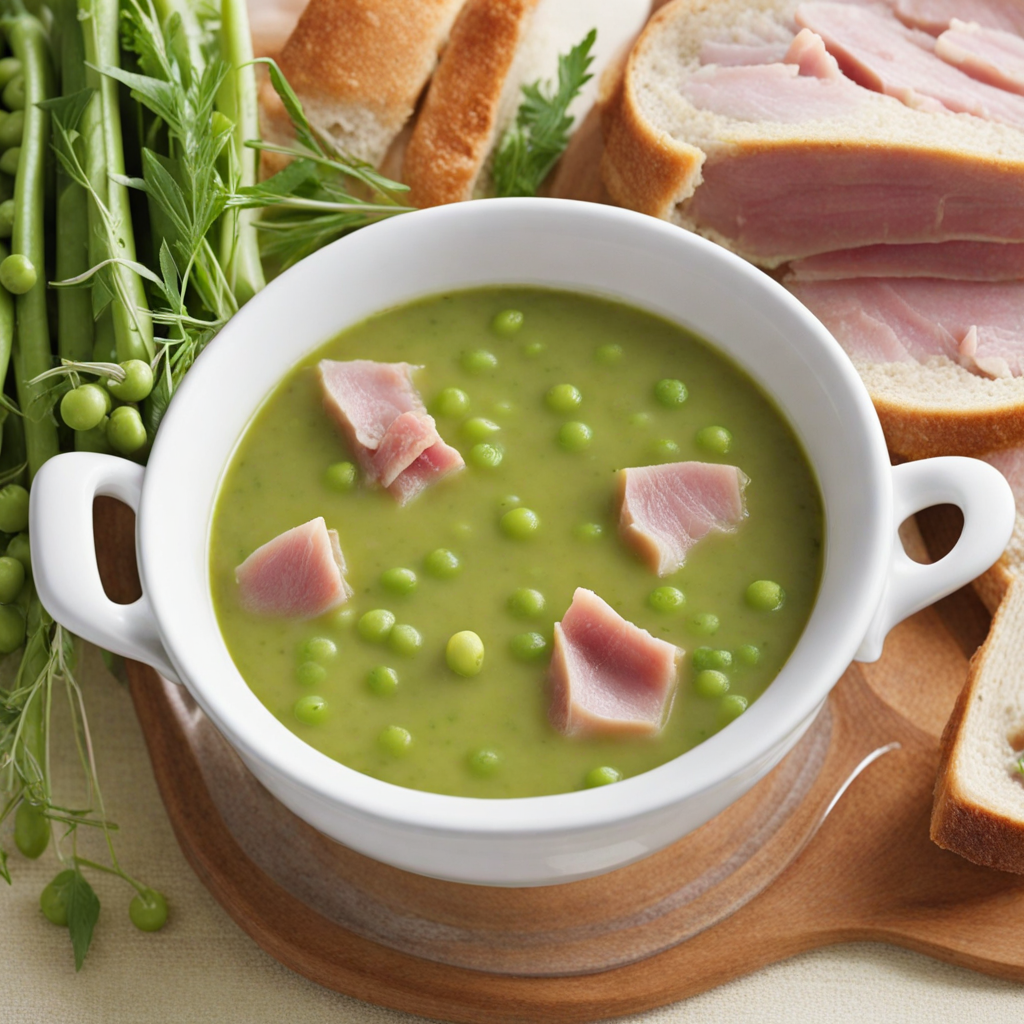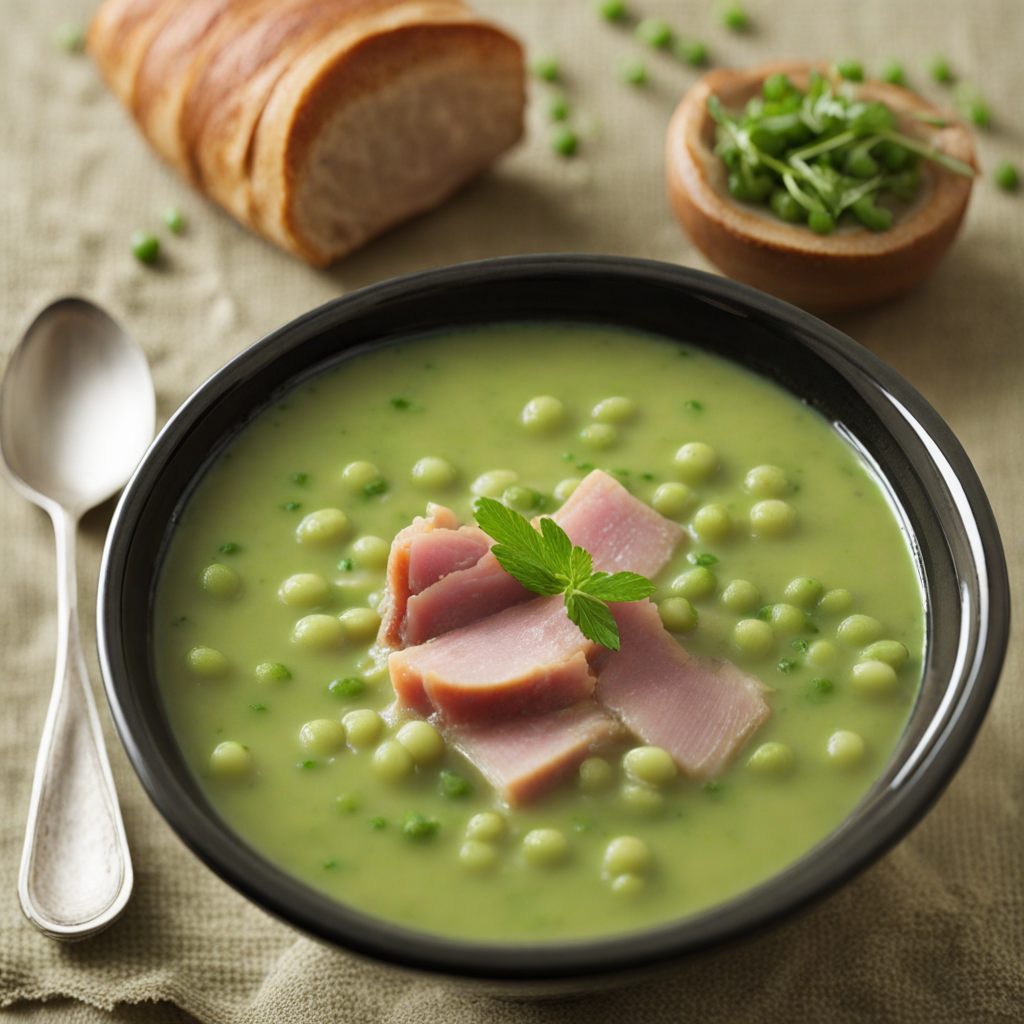Pea and Ham Soup
Pea and Ham Soup is a beloved dish in Australia, celebrated for its hearty nature and comforting flavors. This rustic soup is primarily made from split green peas and ham hocks, creating a dish that is both nourishing and satisfying. Its origins can be traced back to traditional British cuisine, where similar recipes have existed for centuries. The adaptation of this soup in Australia reflects the country's colonial history, where British settlers brought their culinary traditions, incorporating local ingredients and flavors over time. The primary ingredients of Pea and Ham Soup include split green peas, which are dried peas that have been peeled and split, making them quick to cook and rich in protein. The ham hock is another essential component; it is the joint of the pig's leg, often smoked or cured, which imparts a robust flavor to the soup. Other common additions are onions, carrots, and celery, which provide a depth of flavor and sweetness. Herbs such as thyme and bay leaves are often included to enhance the taste, while salt and pepper are used to season the dish. Preparation of Pea and Ham Soup is relatively straightforward, making it a popular choice for home cooks and families. The split peas are usually rinsed and then simmered in a large pot with the ham hock and vegetables. The cooking process often begins with sautéing the onions, carrots, and celery in a little oil or butter until they become tender, which helps to release their natural sweetness. Then, the split peas and the ham hock are added
How It Became This Dish
The History of Pea and Ham Soup in Australia Pea and ham soup is a dish that resonates deeply with the Australian culinary landscape, embodying the spirit of comfort food while also reflecting the country’s diverse cultural influences. Its history is a rich tapestry woven from indigenous practices, colonial influences, and the evolution of Australian society. #### Origins and Early Influences The roots of pea and ham soup can be traced back to ancient cultures, where legumes were a staple in diets across the globe. Peas, particularly the split yellow variety, were cultivated in the Middle East and Europe for millennia. They were celebrated not only for their nutritional value but also for their versatility in various dishes, including soups. When European settlers arrived in Australia in the late 18th century, they brought with them their culinary traditions. The early British colonists, who had settled in New South Wales, relied heavily on preserved foods and ingredients that could withstand long sea journeys. Salted meats, particularly ham, were a common staple, often paired with legumes like dried peas to create hearty, filling meals. This combination was not only practical but also economical, making it an essential dish for early settlers facing the harsh realities of colonial life. #### Cultural Significance Pea and ham soup quickly became a popular dish among settlers, embodying the warmth and comfort of home-cooked meals in a new and often challenging environment. The soup served as a reminder of the familiar tastes of Britain, helping to bridge the gap between the old world and the new. It was a dish that could be easily prepared in large quantities, making it ideal for families and communal gatherings. As the population grew, so did the cultural influences on Australian cuisine. The soup began to take on regional variations, adapting to local ingredients and tastes. For example, in the colder southern regions, particularly Tasmania, the dish became a winter staple, often enjoyed with crusty bread. In the warmer northern areas, the soup was sometimes lightened with fresh herbs and vegetables, reflecting a shift towards fresher, lighter meals in warmer climates. #### Development Over Time In the 19th century, with the establishment of rural communities and the expansion of agriculture, peas became more widely cultivated in Australia. Farmers began to take pride in their local produce, and pea and ham soup evolved from a simple, utilitarian dish to a beloved staple that showcased Australian ingredients. The soup became a symbol of hospitality, often served at gatherings and community events. The introduction of canning technology in the late 19th and early 20th centuries revolutionized food preservation, making it easier for households to store and enjoy this hearty dish year-round. Canned pea and ham soup became a popular convenience food, leading to its association with home cooking and nostalgia, especially during the Great Depression and World War II, when many families relied on affordable, filling meals to stretch their budgets. #### Modern Interpretations In contemporary Australia, pea and ham soup has enjoyed a renaissance, with chefs and home cooks alike exploring new flavors and techniques while honoring traditional recipes. The rise of the farm-to-table movement has encouraged a return to fresh, locally sourced ingredients, prompting many to use fresh garden peas and artisanal hams. In addition, the dish has found its way into fine dining establishments, where chefs experiment with gourmet versions, incorporating elements like smoked meats, gourmet stocks, and innovative garnishes. This evolution speaks to the broader trends in Australian cuisine, which celebrate multicultural influences while maintaining a connection to local ingredients and traditions. #### Cultural Connections Pea and ham soup has become more than just a dish; it is a cultural touchstone for many Australians. It evokes memories of family gatherings, winter evenings by the fireplace, and community events. Its presence in homes and restaurants alike underscores its significance in the Australian culinary identity. Moreover, pea and ham soup has found its place in popular culture, appearing in cookbooks, television shows, and even local festivals that celebrate traditional Australian food. It serves as a reminder of the country’s history, resilience, and ability to adapt and thrive through adversity. #### A Dish that Unites In a country as diverse as Australia, where various cultures intersect, pea and ham soup stands out as a unifying dish. It transcends generational divides, being equally cherished by those who grew up with it and newer generations who may discover it through modern culinary channels. From the early settlers to contemporary chefs, pea and ham soup has been a canvas for creativity and expression. It allows for personal interpretation—each family may have their own secret ingredient or method, passed down through generations. This sharing of recipes and stories further enriches the dish's history, reinforcing its place in the Australian food narrative. #### Conclusion As we reflect on the history of pea and ham soup in Australia, we recognize it as more than just a comforting bowl of food; it is a reflection of the country’s journey, its evolving culinary landscape, and its diverse cultural heritage. From its humble beginnings as a practical meal for early settlers to its status as a cherished comfort food and gourmet dish, pea and ham soup remains a beloved staple in Australian kitchens. It captures the essence of community, tradition, and adaptability, ensuring its place in the hearts and homes of Australians for generations to come. Whether enjoyed on a chilly evening or served at a festive gathering, pea and ham soup continues to nourish both body and soul, embodying the warmth of Australian hospitality.
You may like
Discover local flavors from Australia







